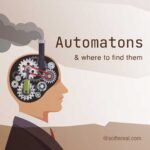Automatons, what they are, and where to find them

“Automatons” or “automata” were first created in the early 19th century and were used as simple toys and demonstration pieces. They are often used as servants or assistants, and sometimes have human-like qualities, such as the ability to speak or show emotions. Some automatons are even capable of human-like movement making them realistic and lifelike. Automatons have also been used in a variety of entertainment settings, such as theme parks and carnivals.
Today, automatons are still used for entertainment purposes, but they can also be found in a variety of other settings, such as manufacturing plants often used to assemble products or to perform other tasks that are repetitive and/or dangerous for humans, and military applications sometimes used as bomb disposal robots or as sentry guns.
What are automatons and what do they do?
An automaton is a self-operating machine or a mechanical robot that operates automatically. Automatons were first created in the early 19th century and were used as simple toys and demonstration pieces. Today, automatons are still used for entertainment purposes, but they can also be found in a variety of other settings, such as manufacturing plants and military applications.
How were automatons first created and how have they evolved over time?
Automatons were first created in the early 19th century as simple toys and demonstration pieces. They were powered by a variety of energy sources, such as springs, weights, or pneumatics. Electrical automatons, on the other hand, were powered by batteries or other forms of electricity. Automatons could be simple or complex depending on their intended purpose.
Over time, automata have evolved and been used in a variety of settings, such as manufacturing plants and military applications. In manufacturing, automatons are often used to assemble products or to perform other tasks that are repetitive and/or dangerous for humans. In the military, automatons are sometimes used as bomb disposal robots or as sentry guns.
How do automatons differ from robots?
Automatons and robots are both machines that can operate automatically, but there are a few key differences between them. Automatons are powered by a variety of energy sources, while robots are typically powered by electricity. Automatons can also be either mechanical or electrical in nature, while robots are always electrical. Finally, automatons are often used in manufacturing or other industrial settings, while robots are more commonly used in research and development or for personal assistance.
What are some of the most famous automatons in history and why are they so famous?
One of the most famous automatons is the Turing machine, which was designed by British mathematician Alan Turing in 1936. The Turing machine is an abstract model of a computer that can be used to perform any calculation that is computable.
Some of the most famous automatons in history are those that were created by Jacques de Vaucanson. Vaucanson was a French artist and watchmaker who created a number of automatons in the 18th century. One of his most famous works was a mechanical duck that could eat, drink, and quack. The duck was so realistic that it fooled many people into thinking it was a real bird. Vaucanson’s other famous automatons include a flute player and a digger.
Another famous automaton is the Jacquard loom, which was invented by French weaver Joseph-Marie Jacquard in 1801. The Jacquard loom is a mechanical loom that uses punched cards to control the weaving pattern.
How do automatons work?
Automatons work in a few different ways, but most are powered by either mechanical or electrical means. A traditional automaton is made up of gears, which often interact with one another to produce the movement for that automaton. These gears can be set up to produce either continuous motion or cyclical motion, depending on the needs of the piece. Electrical automatons, on the other hand, are powered by batteries or other forms of electricity. These automatons typically use motors to produce their movement.
What are some of the challenges associated with automatons?
One of the biggest challenges associated with automatons is their cost. Automatons can be very expensive to produce, especially if they are complex in nature. Additionally, automatons require regular maintenance and repairs, which can also be costly. Automatons can also be dangerous, as they are often powered by mechanical or electrical means. If an automaton is not properly maintained, it could malfunction and cause injury or even death.
How much does an automaton cost?
An automaton can cost a lot of money to produce, depending on its complexity. The Turing machine, for example, is a very complex machine and can cost several thousand dollars to build. Some automatons used in manufacturing plants can cost tens of thousands of dollars to produce. Automatons typically require regular maintenance and repairs, which can also be costly.
Are automatons still produced today?
Yes, automatons are still produced today, but they have largely been replaced by robots in most settings. Automatons are still used in some manufacturing plants and in the military, but they are not as common as they once were. Many museums also have exhibits of automatons, which are often used to demonstrate the history and evolution of technology.
Where can you find automatons today and what are some of their uses?
Automatons can be found today in a variety of settings, such as manufacturing plants and the military. In manufacturing, automatons are often used to assemble products or to perform other tasks that are repetitive and/or dangerous for humans. In the military, automatons are sometimes used as bomb disposal robots or as sentry guns.
There are a number of museums around the world that feature exhibits of automatons. One of the most famous is the Musée des Arts et Métiers in Paris, which has a large collection of automatons dating back to the early 19th century. The museum also has a working replica of Joseph-Marie Jacquard’s 1801 loom, which was one of the first machines to use punched cards to control a weaving pattern.
Locations to view automata in the US
- The Metropolitan Museum of Art (The Met), New York
- Morris Museum, Morristown, New Jersey
Locations to view automata in Europe
- The Museum of Automata and Modeling, La Rochelle, France
- Kunsthistorisches Museum Wien, Vienna, Austria
Events & Fairs
- AutomataCon, yearly convention organized by the Morris Museum, NJ








